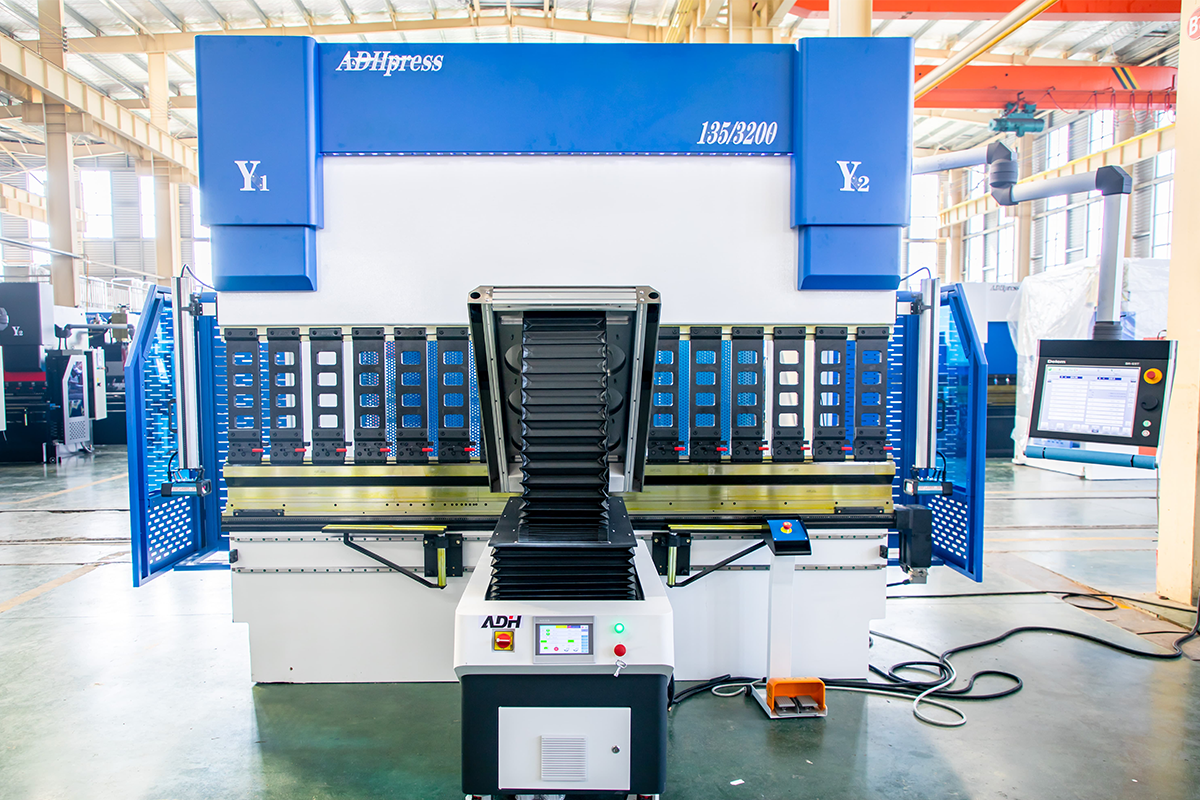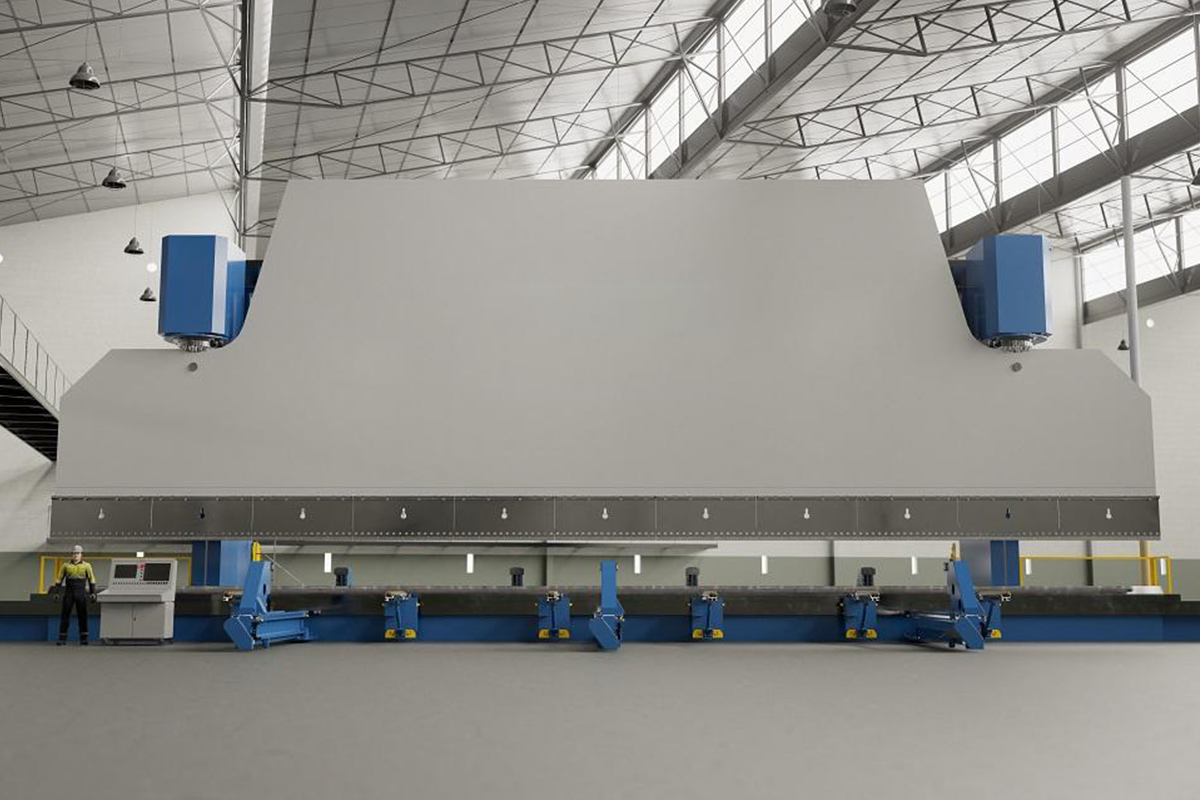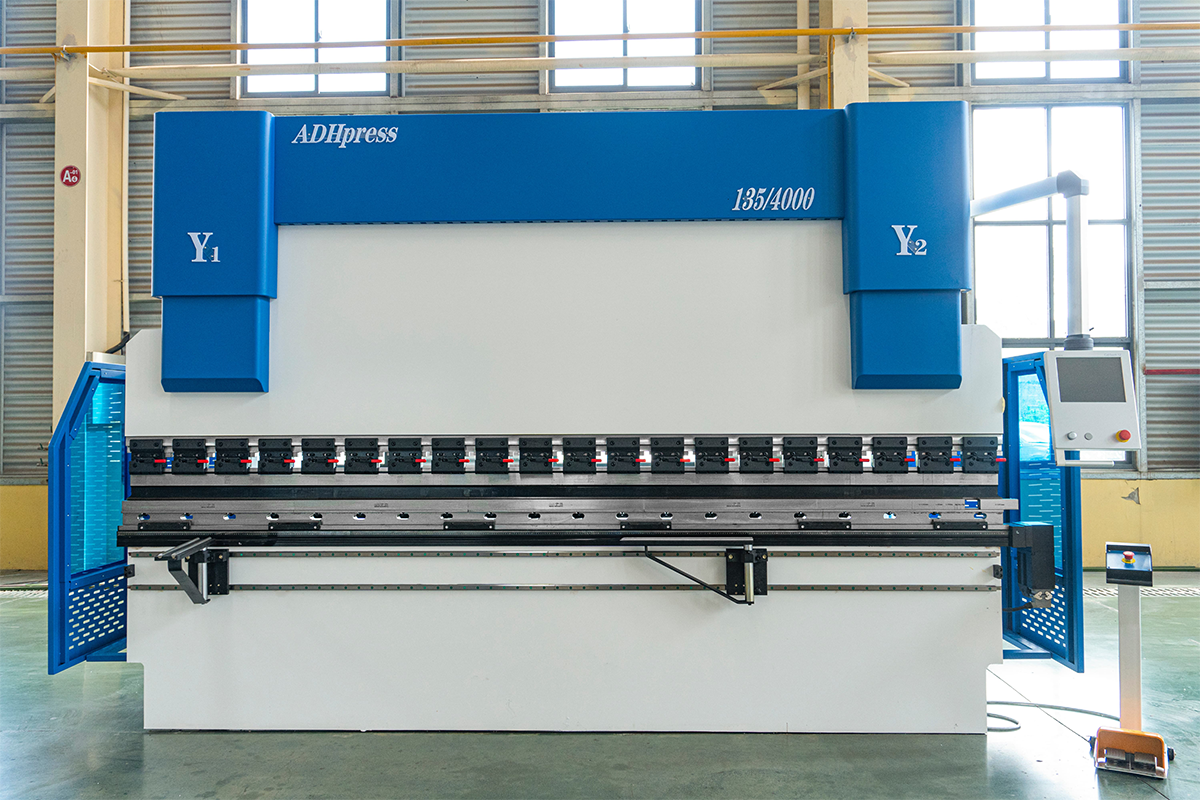Press brake is an essential metal manufacturing machine that can utilize punch and die to bend the metal sheet into the required shape. The press brake is widely used in many aspects, like vehicle manufacturing, rail transit, and vehicle manufacturing, and it plays a pivotal role in metal forming. With the continuous development of manufacturing, the manufacturing requirement for larger metal parts’ shapes continuously increases. In order to meet the increased market demand, machine tool manufacturers continuously expanded the size and specification of the press brake. Up to 2023, Ursviken Technology sold the biggest press brake ever produced in the industry---- a bending force of 5,500 tons and a bending length of 73 ft. Our passage will discuss the role of press brakes in metal manufacturing and the features and applications of the biggest press brakes in the world. Press brake is a mechanical equipment widely used in metal sheet fabrication. Its main function is to bend the metal sheet to the required angle and shape through exerting pressure. It forms the anticipated bending through putting the workpiece between the matched top punch and bottom die. The working principle of the press brake is to exert force on the metal sheet. The workpiece is laid on the surface of the bottom die. The top punch will descend through a mechanism or hydraulic pressure, which forces the metal sheet to bend between the two parts. Different types of press brakes vary from each other in control systems and transmission mechanisms. However, they are the same as the primary working principle, which is transforming the shape of the metal sheet via exerting force. Mechanical press brake: this is the most traditional type of press brake. It is operated by a mechanical system driven by flywheel and clutch. Although slow, it is still widely used owing to its simple structures and low cost. Hydraulic press brake: it uses a hydraulic system to move the punch, thus increasing the pressure and force during the bending process. CNC press brake: it achieves high-precision control through CNC technology, which is suitable for metal fabrication required by high precision and complex shapes. Press brake plays a pivotal role in the construction, automotive, and aerospace industries. In construction, it is used to make structural elements such as steel bars, frames, etc. In automotive processing, it is used to process bodies, frames, and other metal components. In aerospace, the press brake is used to manufacture metal parts and frames for aircraft. The history of press brakes dates back to the Industrial Revolution period. At that time, operating the press brake mainly depended on manual and simple mechanical equipment. With the development of technology, in the early 20th century, the mechanical press brake appeared. It uses mechanical wheels and a lever system to exert pressure, improving efficiency and precision. In the mid-20th century, the invention of hydraulic press brake further improved the performance of the press brake. The input of the hydraulic system not only improves the bending strength but also offers more smooth and stable pressure control, making the fabrication more precise and efficient. In the late 20th and the early 21st century, the application of CNC technology stood for a significant leap in press brake technology. CNC press brakes can control the bending process accurately, achieving precise processing with intricate shapes. This technology not only dramatically improves fabrication efficiency and precision but also greatly expands the press brake application sphere and function. Automatic and intelligent: with the development of artificial intelligence and machine learning technology, the press brake started to achieve a higher level of automation and intelligence. These technologies enable the machine to adjust the parameters automatically and self-diagnose and maintain, significantly improving production efficiency and reducing human error. Precision and speed improvement: the modern press brake has been improved in precision and speed through consistent technological invention, which can meet the more strict industrial criteria and complex design requirements. Material and energy efficiency: utilizing the new material and improving the energy efficiency are also essential aspects of the press brake. This not only reduces the production cost but also reduces the impact on the environment. Bearing capacity: large press brake boosts for its high bearing capacity. This means it can bear and process more extensive and thicker metal sheets. This ability is usually measured by tonnage. The tonnage of a large press brake is usually 1000 tonnage or more, which is heavier than the common press brake type. Working length: except for bearing capacity, the working length is also essential for verifying whether the press brake is of a large type. The large press brake usually has a longer worktable and bending length, usually 4 meters or more. This allows for easy access to more extensive materials. Machine size: the giant machine looks tremendous in volume and is usually 6 meters or more long. This not only contains the workbench length for matching large workpieces but also contains the height and width of the machine, making them occupy more space. Working speed: the large press brake's working speed is ten beats per minute or faster, improving the working efficiency. High-level control system: in order to deal with material of considerable size and high bearing capacity, the large press brake is usually equipped with a control system. These systems can offer more precise bending angle, pressure, and speed control. Multi-axes back gauge system: the large press brake is usually equipped with a multi-axes back gauge system, which is of vital importance to handling large material. This system can ensure the precise position during the bending process. Strengthened stability and durability: because of heavier loading, the large press brake pays more attention to stability and durability when designed. This means larger materials can be handled. Custom function: the large press brake is usually custom-made according to the specific industrial application. This includes special tools, an expanded workbench, and specific software equipment. Until 2023, Ursviken Technology has sold the industry's biggest press brake ever produced. This machine is famous for its tremendous size and advanced function, which proves the technology innovation in the metal manufacturing sphere. Its bending force is 5000 tons, and its bending length is 73 ft, making it very easy to handle highly demanding bending tasks. The advancement of the press brake not only lies in its size but also improves its ability to bend larger and thicker metal sheets. It utilizes the advanced power and control system to improve efficiency. It is equipped with the most advanced automatic technology, including automatic upper die replacement, changing dies, and utterly programmable back gauge, thus improving production, precision, and convenient operation. Besides, it is equipped with an advanced CNC system, which can improve flexibility and controllability during the bending and forming process. Moreover, owing to its energy-saving design, it simplifies the working process and saves the cost. Also, safety is critical, and it is equipped with advanced safety functions. The biggest global press brake not only shows cutting-edge engineering technology but also highlights the globality of manufacturing. Although the machine is made in Sweden, it impacts the world, including America, which owns the advanced and strong manufacturing equipment. Trumpf: as a leader of the industrial mechanism, Trumpf is renowned for its press brake with high precision, innovative technology, and reliability. Their large press brake model is widely used in the world. Amada: Amada is another renowned press brake manufacturer founded in 1946. It is famous for its high performance and technological innovation. Its large press brake is very suitable for precision machining and mass production. Accurpress: Accurpress is highly praised by the industry for its custom handling solution and highly reliable machine. The large press brake can meet the strictest industry criteria and customers' specific needs. Initial cost investment: purchasing a large press brake requires a significant initial investment. The cost includes purchasing, transporting, installing, and training workers. Operation cost: the cost of a large press brake may include energy consumption, routine maintenance, component replacement, and probably technology advancement. Production efficiency improved: the press brake can significantly improve production efficiency and reduce production time, and human labor, especially under the circumstance of mass production. Quality improved: improving the production quality can reduce waste rate, reduce maintenance and replacement costs, and increase market competitiveness. Improve production ability: the large press brake can handle larger materials and offers more extensive market opportunities, including the ability to accept big projects. Market competitive advantage: the large press brake can make the enterprise, which can offer larger-scale and higher quality products, more competitive, appealing to more customers, and increase market share. Long-term profit increasing: although the initial cost is high, the large press brake can bring consistent and increasing profit to the enterprise in the long term through improving production efficiency and quality. Technology leadership: investment in the advanced large press brake also means the enterprise is a leader in the technology, which is a critical competitive advantage of the fast-changing market. Energy consumption: due to its scale and operation intensity, the large press brake usually consumes much energy. Therefore, lowering energy consumption is the key to reducing the environmental impact. Emission control: although the press brake itself may not emit pollution. However, producing energy used during its operation may generate carbon dioxide and other greenhouse gas emissions. Therefore, cleaning energy or improving energy efficiency is an important way to lower the overall environmental influence. Noise pollution: the large press brake may generate a lot of noise during operation. This may not only impact the operator's working environment but also disturb the surrounding environment. Resource utilization and waste management: during the process of press brake manufacturing and maintenance, what should be noticed is the choice of material and the waste handling to reduce resource waste and environmental pollution. Energy-saving design: the modern large press brake increasingly adopts energy-saving design, such as using high-efficiency motors and pumps and optimizing the control system to reduce energy consumption. Renewable energy technology: some press brake designs include energy-renewable technology, such as recovering energy from other operation processes during the bending process. Intelligent control system: the large press brake can operate more precisely through a high-level control system, which can reduce energy waste, such as controlling the pressure and movement speed through precise control, which can not only improve efficiency but also lower consumption. Regular maintenance and optimization: regular maintenance and optimizing the machine can ensure it is in good condition and reduce unnecessary energy consumption. Using clean energy: if possible, electricity using renewable resources (like solar energy and wind energy) can greatly decrease the environmental impact of the large press brake. The demand for the large press brake is constantly increasing under the push of many factors. Industries such as aerospace, shipbuilding, and heavy equipment manufacturing require the large press brake in that they can provide bending and form large-scale metal sheets. This demand comes not only from the requirement for large machines but also from the precision and efficiency of these large press brakes. In North America, Europe, and parts of Asia, fundamental infrastructures and renewable energy projects have been invested, further stimulating the demand for large-scale metal manufacturing tools. The new economy is not far behind; India, China, and Brazil are expanding their manufacturing ability, thus increasing the demand for large-scale press brakes. The large press brake market is developing as the technology develops. CNC technology and automation promote the development of more complex and more efficient press brakes. The advancement of the technologies not only strengthens the function of the large press brake but also makes them more energy-saving and easy to operate. The prospects of the press brake seem full of hope. With the constant advancement of sustainable practice, the requirement for large-scale, highly efficient, and advanced technology is expected to increase. Besides, the custom and specialized metal manufacturing trend may stimulate innovation. The biggest press brake in the world symbolizes the superior ability in modern manufacturing. Its importance not merely lies in size but proves the human intelligence and persistent pursuit of the industrial process and efficiency and precision. Our company, ADH Machine Tool, has specialized in producing press brakes for over 40 years. Welcome to browse our official website for knowledge learning or professional consulting. Yellow brown liquid, Polymer Dispersant, Dispersant For Uv, Organic Pigments, Dispersant Guangzhou Chengbian Chemical Technology Co., Ltd. , https://www.gzcbct.comI. Introduction
II. Understanding Press Brakes
Definition and basic function
Working principle
Types
Importance in the industries
III. The Evolution of Press Brakes

Historical perspective
Technological advancements
IV. What Defines a 'Big' Press Brake?
Criteria for size and capacity
Key features of large-scale press brakes
V. The World's Largest Press Brakes

Overview of the largest press brakes globally
Discussion on the manufacturers
VI. The Economic Impact of Big Press Brakes
Cost-benefit analysis for businesses
ROI considerations
VII. Environmental Impact and Energy Efficiency
Environmental considerations in the operation of large press brakes
Energy-efficient technologies and practices
VIII. Global Market and Demand Trends

Analysis of the global demand for large press brakes
Market trends and future outlook
IX. Conclusion
CB-3025 is a polymer Dispersant that is widely used in solvent-based coating systems. It shows excellent grinding and dispersing effects on carbon black and Organic Pigments. It has good versatility and is widely used in the production of oily color pastes.